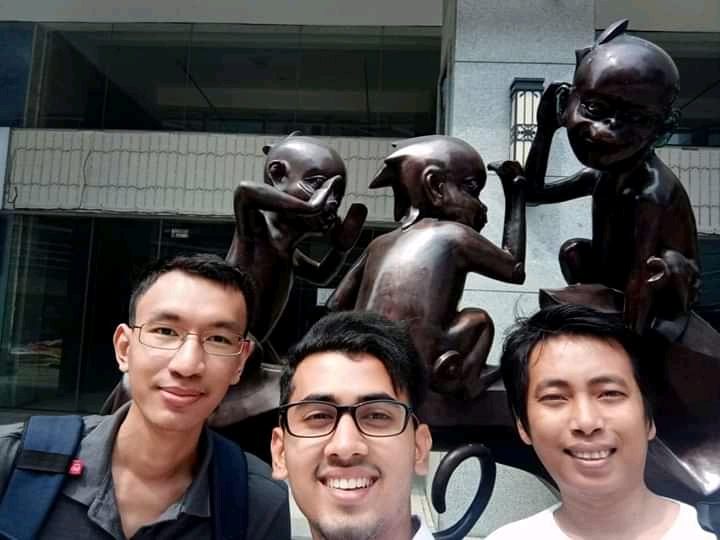Can you get a water refill in Myanmar? Yes you can! Today we want to inform you about a promising new refill project, situated in Yangon, Myanmar. Last year, three ambitious students founded RefillMe. Starting small, dreaming big. We just met and immediately became fans. Sit back and enjoy our interview with Haling Min Aung, co-founder of RefillMe.

INTERVIEW WITH HALING MIN AUNG, REFILLME (YANGON, MYANMAR)
Can you tell us a bit about yourself, and your role at Refill Me Yangon?
Mingalarpar! My name is Haling Min Aung. I work in Earth Day Network Myanmar as an assistant manager, while also managing communications at RefillMe. Furthermore I am an activist educator in Yangon. I strongly believe that climate change should be taught in every school as the future of our Earth depends on our ability to take action.
Mingalarpar (what an amazing way to say hello)! Why and when did you start this project?
After completing an environmental studies program from the University of Yangon, we decided to tackle environmental issues in Myanmar by initiating projects. We initiated the first one, RefillMe, in November 2019.
So you already completed the first half year. We’ll talk more about the project soon. But first: who are ‘we’? Can you tell something about the team?
Sure! Other team members are my classmates from the environmental studies program. My teammate Aung Pyi Soe coordinates the RefillMe project and fellow teammate Ye Myo Zaw conducts the refill pilot in Yangon.

That’s nice. Many environmental projects (including Refill Ambassadors) start with only one advocate, and RefillMe already has three. What did you do with the refill pilot in Myanmar? How did it go so far?
The refill pilot is carried out to address issues and challenges faced during the registration process of public refill stations. It is successfully done in two townships of Yangon by using observational study as a means for gathering information. Currently, we are working together with Thant Myanmar to map Yangon (Thant Myanmar is a non-profit organisation, aiming to reduce the use and dependency on single-use plastics).

Refill station on the streets of Yangon 
Refill station in Yangon Bakehouse
Very smart, we highly recommend people to team up with other NGO’s and (local) action groups. Together, we can create more awareness. What kind of bottles do people use when they refill in Myanmar?
Refillers use aluminium bottles, stainless steel bottles and polycarbonate bottles. Reusing PET bottles is also common in Myanmar.
TAP WATER IN MYANMAR
Mmm, just like we do in the Netherlands. Here we drink directly from the tap. How is tap water quality in Myanmar? Do local people drink tap water? Or do you drink with filters?
There is strict regulation for water quality that is supplied, however water quality varies from region to region. Factors like flooding, lack of safe water storage, old infrastructures and pipes affect the water quality. That is why people don’t drink right out of the tap. Households use filter or boil the water for consumption.

Good to know. Another question: is there plastic deposit on plastic bottles in Myanmar? How is the plastic recycling infrastructure?
To our knowledge, there is no formal plastic deposit on bottles in Myanmar but you can get some cash back by selling plastic bottles to waste collectors. Recycling activities in Myanmar are carried out mostly by the informal sector, which includes scavengers, waste collectors, and waste dealers. These scavengers and waste collectors collect recyclable materials such as newspapers, books, cardboards, metal, plastic bottles, tin and glass from households, commercial areas and streets and in turn sell these items to waste dealers who clean and sell them to the recycling industry both locally and for export. We also have local plastic recycling start-ups and NGOs.
That sounds a bit chaotic but it can work. We think avoiding and reducing single-use plastics is better than recycling, but plastic-recycling can be useful to create new materials. And some people make a living out of it. We are curious to learn more about these recycling start-ups. And of course, to learn more about RefillMe, but we won’t steal any more time. Last question: what are your next steps?
We plan to look for new partners to facilitate our project expansion. RefillMe is more than just adding stations to reduce plastic consumption. Our team is using a more holistic approach to consider things like water quality, accessibility, affordability, and aesthetics which can help us accelerate progress towards UN Sustainable Development Goal 6 in Myanmar (clean water and sanitation). We dream about going beyond RefillMe project. Currently, we are working hard to launch two new projects in August.
Thank you so much Aung, we’re looking forward to hear more from you and your team!
STAY UP TO DATE ON REFILLME
Want to know more about RefillMe? Follow RefillMe on facebook or leave your message below. And if you happen to visit Myanmar, bring your empty bottle and pay attention to the refill stations. Join the #refillution!
All images in this blogs are provided by RefillMe.



